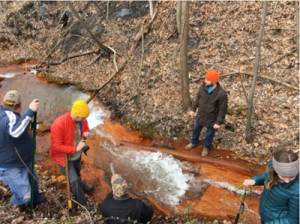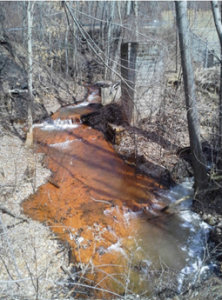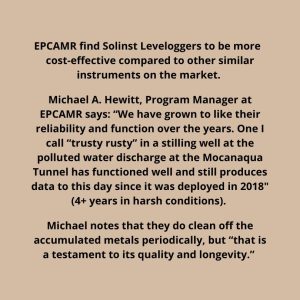 Here’s an interesting case study from the USA about a not-for-profit-led collaboration that’s helping reclaim and remediate abandoned mine drainage, with the help of some reliable Solinst Leveloggers.
Here’s an interesting case study from the USA about a not-for-profit-led collaboration that’s helping reclaim and remediate abandoned mine drainage, with the help of some reliable Solinst Leveloggers.
Coal mining in Pennsylvania has a long history, supplying a significant portion of the state’s electric power generation. However, the now abandoned mines have left more than 5,000 miles of streams polluted by their consequential drainage. The Eastern Pennsylvania Coalition for Abandoned Mine Reclamation (EPCAMR) was established in 1996 to address this issue, facilitating the remediation and reclamation of the land and water polluted by previous practices.
A not-for profit organisation, EPCAMPR collaborates with various stakeholders, including conservation districts, mining companies, and concerned citizens. Their goal is to reclaim and remediate polluted land and water, improving water quality and promoting land redevelopment.

Tunnel discharge from an abandoned mine in Pennsylvania merging with treated wastewater
Since 2018, EPCAMR has run a water monitoring project in Mocanaqua, where an abandoned coal mine called the West End Colliery causes polluted mine drainage discharge into the Susquehanna River. This discharge captured the interest of the Susquehanna River Basin Commission (SRBC), which regulates water withdrawals for consumptive use. Consumptive use (CU) is water that is consequently used in a way that means it cannot be returned to the environment without some form of degradation to its quality or quantity.
To mitigate the impact of mine drainage, the SRBC explores options such as water storage and treatment in flooded underground mine pools. By controlling the discharge and implementing treatment measures, clean water can be supplied to the river basin, benefiting both the environment and consumptive users.
EPCAMR’s water monitoring program in Mocanaqua uses Solinst Leveloggers to measure water levels and understand water movement through the site. The data collected helps estimate water storage volumes and evaluate different mine drainage treatment options. The Leveloggers have proven to be reliable and cost-effective tools for EPCAMR’s monitoring efforts.
Combined with EPCAMRs 3D mine pooling mapping initiative, the field monitoring project provides valuable insights into water flow, storage capacity, and treatment potential of the abandoned mine site.
Through the dedicated efforts of organizations like EPCAMR and the use of advanced tools like Solinst Leveloggers, progress is being made in reclaiming and remediating abandoned mine drainage, ensuring a cleaner and sustainable water supply.


If you would like to learn more about how EPCAMR is using Solinst Levelogger water level dataloggers in their field monitoring projects check out the original article here: Reclaiming & Remediating Abandoned Mine Drainage (solinst.com). If you’re interested in how the Solinst Levelogger can be adapted for your individual project needs, contact HydroTerra so we can create a bespoke solution for you.





